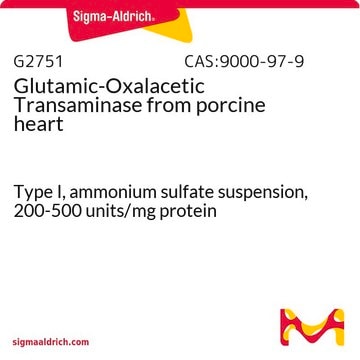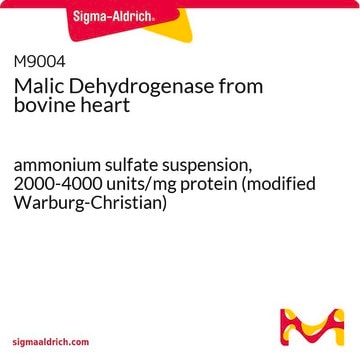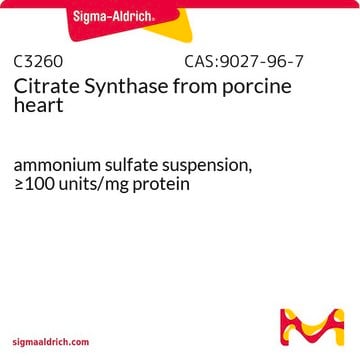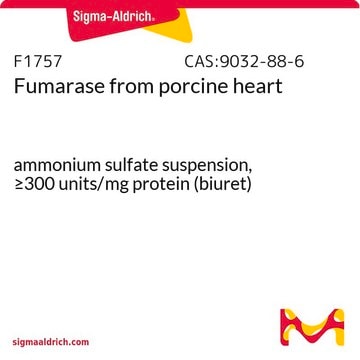LMDH-RO
Roche
L-Malate Dehydrogenase (L-MDH)
from pig heart (mitochondrial)
About This Item
Productos recomendados
origen biológico
Porcine heart (mitochondrial)
Nivel de calidad
formulario
solution
suspension
actividad específica
~1200 units/mg protein (At 25 °C with oxaloacetate as the substrate.)
envase
pkg of 1 mL (10127248001 solution)
pkg of 1 mL (10127256001 suspension)
pkg of 5 mL (10127914001suspension)
fabricante / nombre comercial
Roche
técnicas
activity assay: suitable
color
white
pH óptimo
7.4-7.5(reduction of oxaloacetate)
9.2-9.5(oxidation of malate)
solubilidad
water: miscible
idoneidad
suitable for Western blot
Nº de acceso NCBI
Nº de acceso UniProt
aplicaciones
life science and biopharma
actividad extraña
Fumarase <0.01%
GIDH 0.001%
GOT 0.001%
GPT 0.00185%
LDH <0.01%
NADH oxidase <0.001%
Condiciones de envío
wet ice
temp. de almacenamiento
2-8°C
Información sobre el gen
Porcine ... MDH2(397039)
Categorías relacionadas
Descripción general
The L-malate dehydrogenase enzyme is a nuclear gene product that is synthesized with a 24-residue amino-terminal signal peptide. This peptide is proteolytically cleaved during the translocation of the enzyme to the mitochondrial matrix.
Aplicación
Acciones bioquímicas o fisiológicas
Calidad
Forma física
Nota de preparación
– arsenate
– Mg2+
– Zn2+
Otras notas
Código de clase de almacenamiento
12 - Non Combustible Liquids
Clase de riesgo para el agua (WGK)
WGK 1
Punto de inflamabilidad (°F)
No data available
Punto de inflamabilidad (°C)
No data available
Certificados de análisis (COA)
Busque Certificados de análisis (COA) introduciendo el número de lote del producto. Los números de lote se encuentran en la etiqueta del producto después de las palabras «Lot» o «Batch»
¿Ya tiene este producto?
Encuentre la documentación para los productos que ha comprado recientemente en la Biblioteca de documentos.
Los clientes también vieron
Nuestro equipo de científicos tiene experiencia en todas las áreas de investigación: Ciencias de la vida, Ciencia de los materiales, Síntesis química, Cromatografía, Analítica y muchas otras.
Póngase en contacto con el Servicio técnico







